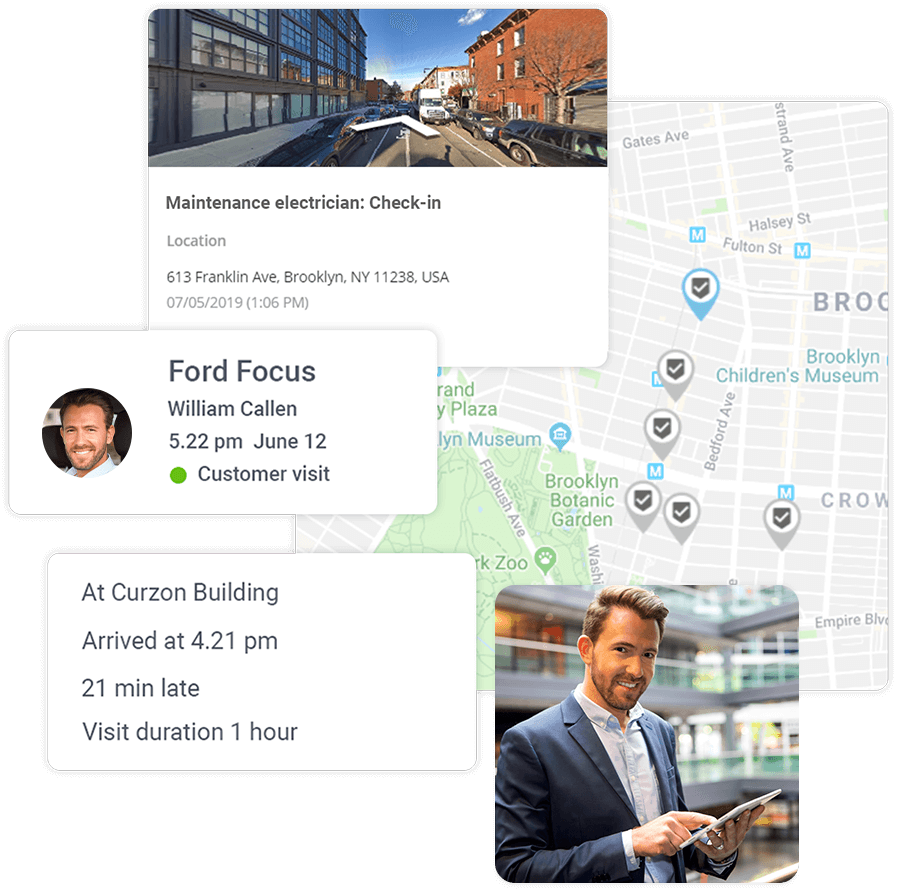What is mobile
workforce management?
Mobile workforce management can be understood as the systems that enable mobile work, including the technologies and processes it takes to achieve efficient and successful service delivery.
Mobile workforce management can be understood as the systems that enable mobile work, including the technologies and processes it takes to achieve efficient and successful service delivery.


Mobile workforce management (MWM) refers to the systems that enable mobile work, including the technology (computers, smartphone, tablets) software, applications, processes, and services, that are used to schedule, monitor, track, and analyze performance of mobile workers as they provide services.
Mobile workforce management solutions are often software as a service (SaaS), which means they require smart device data or an internet connection to operate, are cloud-based, and portable so they can be used on demand.
Due partly to the impact of COVID-19 and the fact that mobile hardware technologies are becoming more affordable, easy to use and portable, the mobile workforce industry is growing so rapidly it’s expected to more than double in value by the year 2027.
Want to learn more? Read the B2Field mobile workforce management essential features guide.
Traditionally, a mobile workforce refers to employees who work “in the field”, or on-site with a customer. Think construction workers, retail workers, realtors, insurance salespeople, or even food truck business owners who aren’t bound to one central physical location or office.
In recent years, the term mobile workforce has expanded to include gig economy employees, or any other remote worker who relies on mobile technology like smart devices and computers to stay connected and collaborate with other colleagues to get their work done.
Additionally, the idea of the mobile workforce is much more than simply working from home. A mobile workforce refers to workers who aren’t bound to a traditional office environment and work on-site or at one or various locations in the field from day-to-day.
The COVID-19 pandemic has greatly impacted traditional work and expanded the idea of the possibilities of the mobile workforce, catalyzing the trend and killing the commute.
Efficiencies catalyzed by technological advancements and innovations allow onsite workers to perform fieldwork that traditionally would have been done from an office, highlighting the changing dynamic of modern mobile work that requires employees to be more productive, capable, and responsive than ever before.


The objective of a mobile workforce is basically to make employees who are constantly on the go as effective as workers who perform duties
in the office.
A modern mobile workforce has the same opportunities as an in-office workforce: the ability to connect to the tools, technologies, and other resources they need to perform their work from anywhere.
That said, it’s not difficult to imagine that the changing dynamic of work now tilts in the favor of a mobile workforce, with about 2 billion people set to enter the global mobile workforce market by 2022.
Partial to completing the objectives of creating a successful mobile workforce are the solutions which are often application-based software as a service (SaaS) technologies. These technologies are deployed to help business leaders and managers manage their employees.
Create, automate and/or edit mobile worker’s schedules
Dispatch mobile employees to new or existing jobs in real-time
Communicate with workers in real time (often via a live-chat platform)
Perform capacity planning for the changing flow of work over time
Track employee locations on a map in real time
Log work information, such as job start, completion and travel times
Track the length of service engagements from start to finish
Track employee performance based on company-client agreements
Connect with existing customer relationship management (CRM) tools
As much as mobile workforce solutions help break the chains of the traditional work environment — giving workers almost instant access to everything they need to work anywhere, as long as there’s internet or data access — mobile work also introduces many challenges.
Generally speaking, the challenge organizations are facing right now is a two-headed beast: that of the rapidly changing culture of work coupled with a rapidly-changing world in general.
The necessary ability to adapt to a world of changing environments has become more important than ever, and it must be achieved at a faster pace than ever. Not a simple challenge for organizations to solve, but one that can be achieved with the right tools.
93,500,000
projected number of mobile workers by 2024
The short answer to this question is “many reasons.” It’s a complicated question that can be illustrated by a few eye-opening statistics.
One study suggests that 75% of mobile workers believe that the traditional office will become obsolete by 2030; 63% of in-office workers agree.
Another study suggests that 80% of candidates would turn down a job offer if flexible working conditions aren’t part of the deal.
In the United States, the projected number of mobile workers is expected to increase from 78.5 million in 2020 to 93.5 million by 2024.
Basically, no matter what industry you’re in, it’s incredibly important to ensure you’re building a strategy to allow and encourage your employees to be part of the mobile workforce.
When your organization gives employees the right tools for the right moment, they’re able to focus on customer service. Mobile workforce management tools help to simplify and streamline the time-consuming processes of work: scheduling, dispatching, and communications.
When all the tools you need are accessible through centralized tools, it means less downtime and less inefficiencies, which translates to improved performance, happier employees, and ultimately, happier customers.
Removing the difficulties that can make every day seem like a chore (see: commuting for work), while providing a better work-life balance is known to increase productivity and decrease sick days. Happier is healthier.
If you don’t have a clear view of the inner workings of the business, it makes it much more difficult to resolve incidents or even pinpoint where those incidents are.
Mobile workforce management solutions provide business transparency in many ways, including real-time status updates, location tracking, performance tracking, and reporting and analytics. Mobile workforce management solutions like B2Field offer seamless integrations into the other systems your business already uses.
Probably one of the more tangible benefits of a mobile workforce is the money your business will save renting a commercial property. Whether we’re talking tens of thousands a year to millions of dollars over many years for a small business, it’s a lot of money that can go straight back into the business instead.
Hire employees around the world, encourage diversity, establish continuous workflows with employees scattered around the globe, and provide 24/7 customer service. If there’s a power outage or other disaster, a scattered workforce can mitigate downtime that would potentially cost a whole lot more if all employees were based on one location that became inoperable.
Meetings and video chats are taking place on mobile devices these days so what’s the point of wasting expenses by having everyone travel to a central location?


Field service management can be confused with mobile workforce management since they’re both related and often discussed in context, but there are key differences between the two.
Although each discipline is concerned with optimizing the processes in their purview, the key difference between them is the difference between human assets (mobile workforce management) and physical assets (field service management).
As previously discussed, modern workforce trends are putting a lot of pressure on organizations to change and to change fast, and these organizations must make room to facilitate these changes while simultaneously providing exceptional client experiences.
Let’s start with the big one, shall we? With customer expectations higher than ever, companies that do an exceptional job of putting their customers first are seeing some serious upside. According to Deloitte research, customers who report positive experiences with clients spend 140% more than customers who report a negative experience.
High expectations propose huge challenges for the mobile workforce. It becomes evermore important for organizations to accommodate their customers’ schedules and to know whether or not their dispatch and employee scheduling tools can keep up with customer demands.
Your organization must answer a very important question: “how can my field employees deliver better on the promises that define the company brand — one of the main reasons clients choose us?”
Mobile workforce management software, like B2Field, is designed to navigate these challenges and help solve them by setting realistic customer expectations by ensuring real-time communications, scheduling, dispatching, and centralizing key business information that allows you to identify, analyze, and execute on the improvements your business needs to grow.
Big data provides your business with the information you need to analyze, identify areas of improvement, and execute on making them. And like any industry that is undergoing rapid growth, mobile workforce management is faced with the challenge of maintaining the level of data collection necessary to stay ahead of the competition.
That said, data collection and data-based decision making is one of the most important parts of managing a mobile workforce because it gives you the insight and transparency necessary to keep your business running smoothly.
Organizations that manage a mobile workforce realize the value of mobile workforce management software that stores and analyzes all the business information that provides key insights and helps business leaders make informed decisions about the direction of the company.
Field employees of the past simply didn’t stay connected to the main office. They received their schedule when they arrived at the office in the morning and went out into the field to complete them. Rinse and repeat. If something went wrong it would have to wait until the end of the day or whenever the field employee went back to the office.
Nowadays, with modern mobile workforce management tools, employees have become more collaborative and agile — able to make changes no matter what the day throws at them.
Information can be sent to the CRM from the field in real time, and employees can access the data they need as they move from customer to customer, and it all happens from a single mobile device.
Modern mobile workforce technology simply provides the agility your company needs to adapt to the unpredictability of field work, and the entire team benefits.
For example, if anything changes during the day, employees can be notified to adapt their schedule in real time, schedulers and the management team can see performance and analyze productivity in real time. Finally, customers will be able to receive more accurate arrival times, keeping them closer and more up-to-date with your service.

The world of mobile work is increasing and improving everyday, but with these improvements come the complexities that make navigating those changes more difficult. Therefore, it’s crucial for organizations to provide their mobile workforce with the tools they need to succeed out in the field.
A modern mobile workforce solution helps companies respond to the changing culture of work by offering automated scheduling, dispatching, streamlined communications, agile data collection and analysis, which are the resources mobile workers need to delight customers and keep them coming back for more.
B2Field’s mobile workforce management software offers automated scheduling, dispatching, real-time communications, and agile reporting and analytics to boost the efficiency and productivity of your mobile workforce — a combination of tools that can provide a clear view into what makes your business succeed and what changes might need to be made for continued growth and success.
Want to learn more about how B2Field can help your mobile workforce succeed? Get in touch with one of our customer service representatives today.
This website uses cookies.
See our Privacy Policy to learn more.